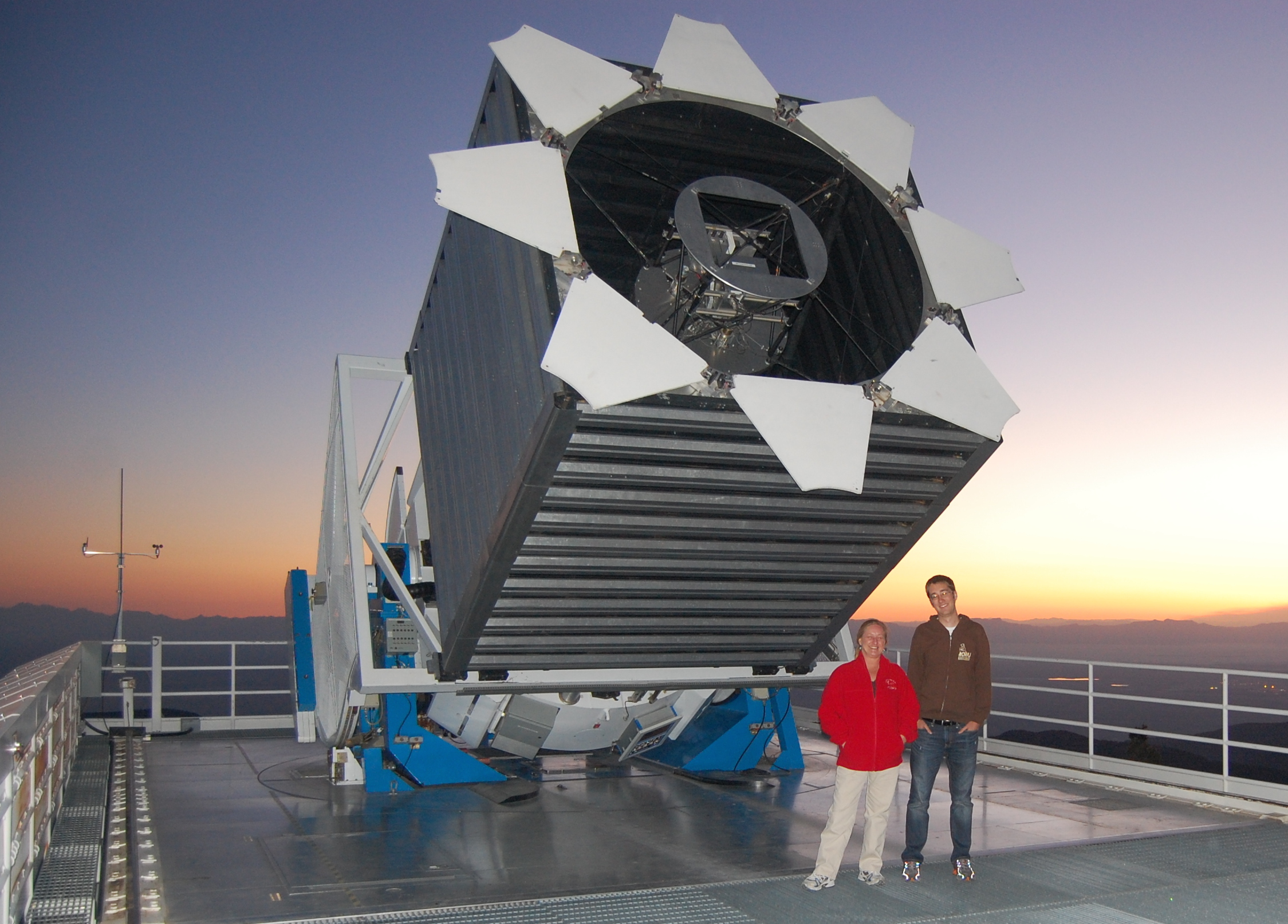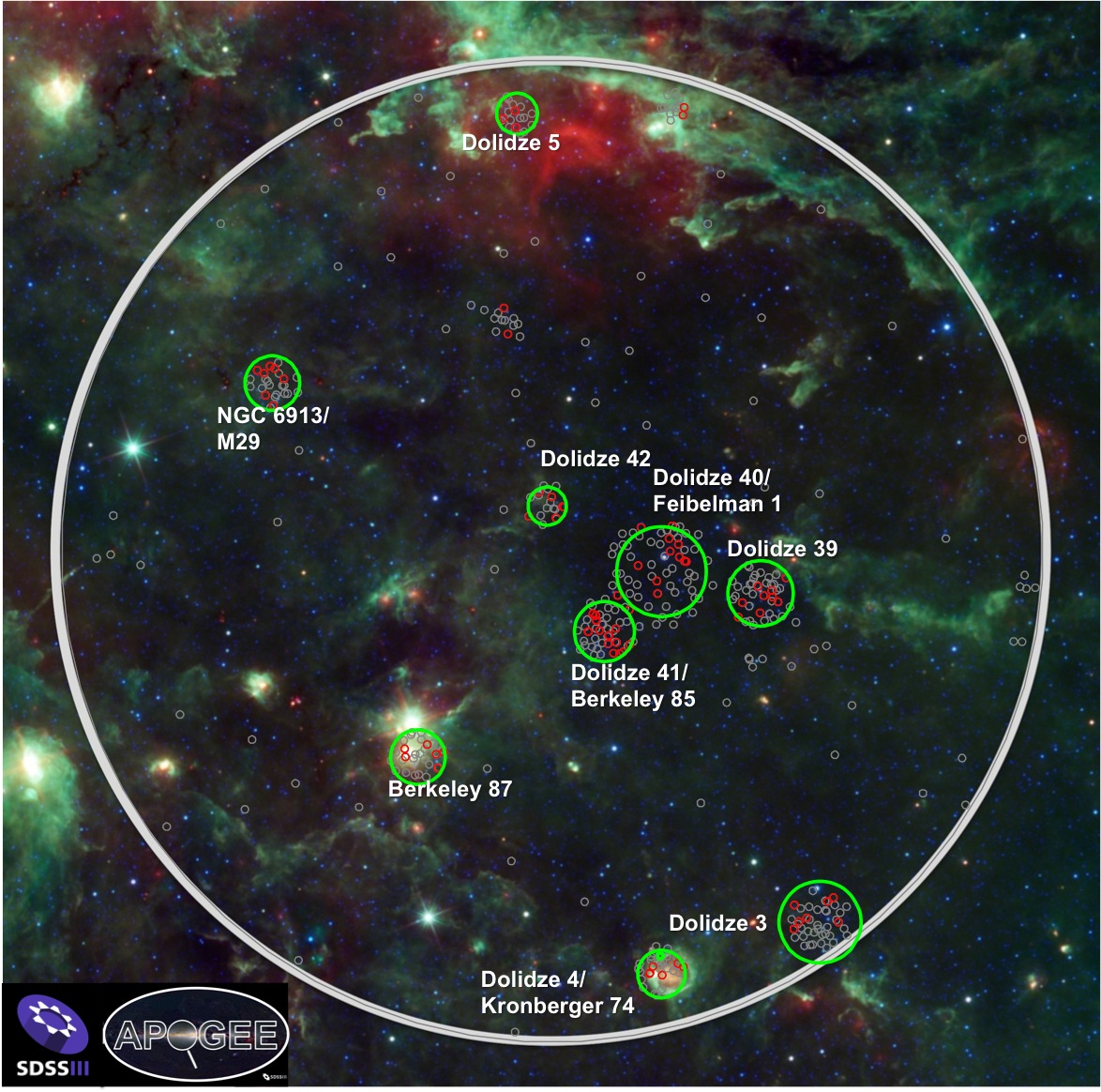The OCCAM survey goals are to create
a high confidence catalog of cluster
age, distance, reddening, abundances
based on uniform data, and utilize
this sample to make marked
improvements to the detailed
chemical measurement of the Milky
Way disk that will inform models of
galaxy evolution.
The OCCAM survey
will utilize large, uniform,
well-calibrated surveys as its
basis, starting with IR photometry
from the Two Micron All-Sky Survey
(2MASS; Skrutskie et al. 2006), the
Spitzer/IRAC-based Galactic Legacy
Infrared Mid-Plane Survey
Extraordinaire programs (GLIMPSE-1,
-2, -3D, 360; Benjamin et al. 2003),
and the Wide-field Infrared Survey
Explorer (WISE; Wright et al. 2010),
combined with spectroscopy from the
SDSS/APOGEE survey. APOGEE will
provide high precision radial
velocities (RVs), stellar parameters
(Teff, log g, [M/H], [C/M], [N/M],
[α/M]), and detailed abundances for
individual elements (Fe, C, N, O,
Al, Si, Ca, Ni, Na, S, Ti, Mn,
K). These data sets will also be
combined with new precision
astrometric surveys as they come
available (e.g., Pan-STARRS and
Gaia; Kaiser et al. 2010; Casertano
et al. 1996).
The OCCAM Project also includes optical high
resolution follow-up of APOGEE stars to
obtain Neutron capture (r- and s- process)
abundances, led by TCU students.
CORE OCCAM PAPERS
OCCAM I: Local Galactic Metallicity Gradient with APOGEE Using SDSS DR10 (Frinchaboy et al. 2013)
Chemical abundance gradients from open clusters in the Milky Way
disk: Results from the APOGEE survey (Cunha et al. 2016)
OCCAM II: Precision Cluster Abundances for APOGEE using SDSS DR14 (Donor et al. 2018)
SDSS-IV OCCAM II Value-Added Catalog (VAC)
OCCAM III: r- and s- Process Abundances for APOGEE Calibration Clusters (O'Connell et al., submitted)
OCCAM IV: Abundances for 126 Open Clusters using SDSS/APOGEE DR16 (Donor et al. 2020)
SDSS-IV OCCAM IV Value-Added Catalog (VAC)
OCCAM V: Chemical Abundances of CTIO/Hydra Clusters using The Cannon (Ray et al., 2022)
OCCAM VI: Galactic Chemical Gradient Analysis from APOGEE DR17 (Myers et al., 2022)
SDSS-IV OCCAM VI Value-Added Catalog (VAC)
OCCAM VII: APOGEE DR17 [C/N]-Age Calibration (Spoo et al., 2022)
OCCAM VIII: Galactic Chemical Gradient and Azimuthal Analysis from SDSS/MWM DR19 (Otto et al., submitted)
SDSS-V OCCAM VIII Value-Added Catalog (VAC)
This work is supported by NSF AAG grants AST-1311835, AST-1715662, AST-2206541.



We present the sample and
methods being used by the survey to determine membership for the
few-star sampling for most clusters as observed by the SDSS/APOGEE.
To determine cluster membership, we have
combined the APOGEE sample with
additional data sets and are using the
three-dimensional kinematical membership
analysis from Frinchaboy & Majewski
(2008) to derive membership probabilities
for each star.
We are adding additional membership criteria
based on APOGEE stellar parameters (e.g.,
Teff, log g, Abundances) to this
formulation, as these are now available
from the APOGEE data.
We are currently working on the DR 20/21 APOGEE + BOSS spectrogragh Milky Way Mapper samples using proper motion
and distance data from the ESA Gaia mission.
This part of the
OCCAM project is
being led by
Jonah Otto, Dr. John Donor, and Dr. Peter Frinchaboy.
Metallicity gradients provide strong constraints for understanding the
chemical evolution of the Galaxy. Using
observations from the APOGEE survey
with chemical abundances were derived
automatically by the ASPCAP pipeline, we
find significant gradients for most-elements.
Our results are not at odds with the possibility that metallicity ([Fe/H]) gradients are steeper in the inner disk (R_GC ~7 - 14 kpc) and
flat towards the outer disk. The open cluster sample studied spans a significant range in age.
When breaking the sample into age bins, there is clear indication that the younger open clusters
has a flatter metallicity gradient when compared with
the gradients obtained from older open clusters.
This part of the
OCCAM project is
being led by Jonah Otto, Dr. John Donor, Dr. Peter Frinchaboy,
Dr. Natalie Myers, and Dr. Katia Cunha (ON, Brazil).
The high-resolution (R=22,500), near-infrared (H-band) APOGEE survey
allows for cluster membership probability
determination and analysis of light and
iron-peak elements. Neutron capture
elements, however, prove to be elusive in
the IR region covered by APOGEE. In an
effort to fully study detailed Galactic
chemical evolution, we conducted a high
resolution (R~50-60,000) spectroscopic
abundance analysis of neutron capture
elements for OCCAM clusters in the
optical regime to complement the APOGEE
results. We present results for open
clusters using data obtained with Keck/HIRES, Magellan/MIKE, McDonald
2.1m/Sandiford Echelle
Spectrograph, McDonald 2.7-m/Coude Echelle, and Lick 3-m/Coude Echelle.
This part of the
OCCAM project is
led by Rajesh Bachchan, Dr. Julia O'Connell and Dr. Natalie Myers